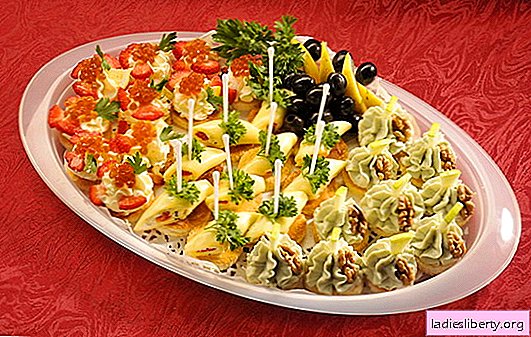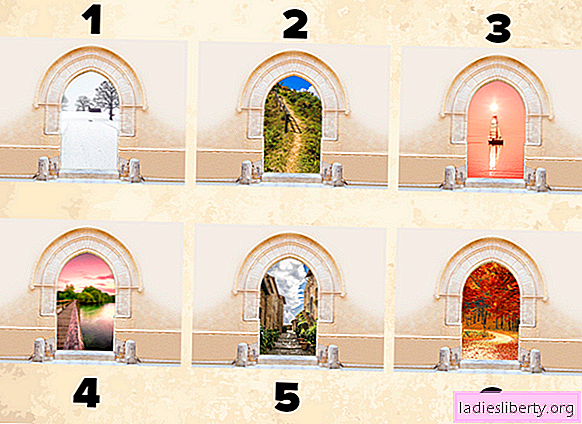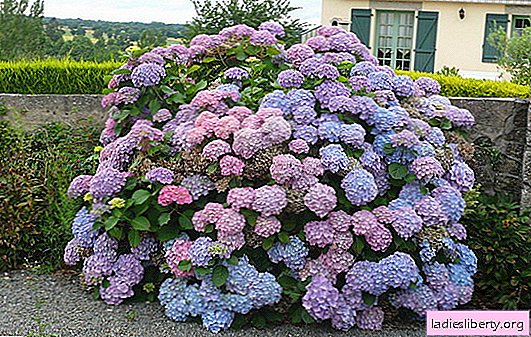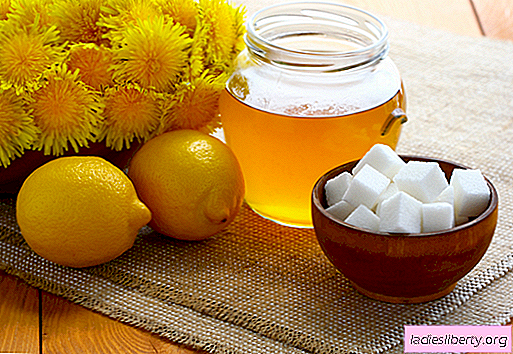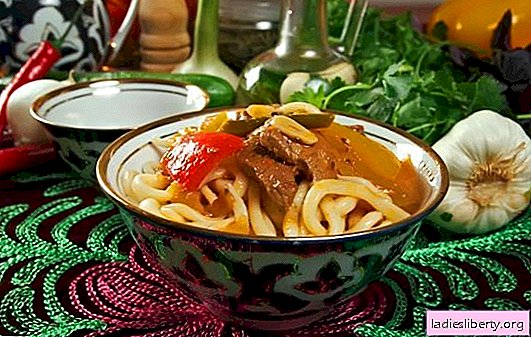
Soft, juicy meat with vegetables in aromatic gravy, delicious noodles, spices, spices and herbs - all this is an Uzbek lagman - a dish that is worth the effort spent on its preparation.
Uzbek Lagman - General Principles
The composition of the dish includes noodles, meat and vegetables. The choice of all ingredients is approached with particular care and even with love - this is a guarantee of the result: taste, mouth-watering appearance and satiety.
Meat. They mainly take mutton, but it can be safely replaced with veal, chicken. The meat is cut into slices of medium size, fried, then stewed with spices and vegetables. Of the spices mainly used are zira, pepper, adjika, suneli hops.
Vegetables. There are no restrictions: tomatoes, sweet and hot peppers, cabbage, radish, beans, carrots, onions and others. It is important that all vegetables are fresh, without rot and no signs of spoilage. Vegetables are cut, rubbed, chopped and spread to meat, simmer until tender.
Noodles. You can buy a finished product, but tastier and more interesting if home-made noodles. Water, flour, an egg and salt are all you need. Knead a tough dough, give it a rest, then roll out, cut, twist, stretch. Masters of their craft achieve that the Lagman noodles reach up to five meters in length.
The lagman is served in a special way: put noodles in a deep plate, put meat and vegetables on top, pour all the gravy in the desired amount, sprinkle with fragrant fresh herbs.
1. Lagman in Uzbek
Ingredients:
On the noodles:
• 250 ml of oil;
• 4 eggs;
• flour - 800 g;
• half a teaspoon of salt.
For waji:
• a small piece of lamb;
• onion - 4 pcs.;
• 1 radish green;
• 0.5 kilograms of tomatoes;
• half the head of garlic;
• 3 carrots;
• a bunch of jusai;
• hot pepper - a couple of pods;
• 6 bell peppers;
• green beans - 6 sticks;
• salt, seasoning - 20 g each;
• fresh celery - 3 stalks.
Cooking method:
1. Knead the dough for noodles: break an egg into a cup, pour salt, flour, pour in oil and mix well. When the dough becomes tight, put it on the table and wring it with your hands. We cover the dough with a film and leave for a couple of hours.
2. Cut the recovered dough into pieces, roll a rope from each. All the resulting flagella are left for half an hour, so that they become more elastic.
3. After the allotted time, the ropes are rolled again, increasing in length, and cut into small pieces of 3 cm. Lubricate them with oil and roll them into long flagella. Grease again with oil and leave under the towel for half an hour. And so we do it several times.
4. We take the plaits rolled out several times by one tip and begin to twist in a circle, often hitting them on the table, to provide them with plasticity.
5. Boil the finished stretched noodles in slightly salt water for 5 minutes, rinse in a colander.
6. Prepare the vaja: cut the onion into rings, carrot, radish into a medium cube, bell pepper into straws, peeled tomatoes into a cube, jusai and green beans into 3 cm thick slices, garlic into slices, cut 1 hot pepper into strips.
7. Cut the lamb pulp into thin strips.
8. Put lamb bones in a pan with hot oil, fry until crispy.
9. Put the flesh to the bones and fry until the juice evaporates and fat is released.
10. Put the onions and fry until light brown onions.
11. Add carrots, beans, radishes, fry until dark carrots.
12. We put hot pepper, chopped celery stalks and tomatoes, season with spices, salt, and fry over high heat for about five minutes.
13. When the juice from the tomatoes boils, put the bell pepper, fry, stirring, a couple of minutes.
14. Pour water until all products are completely covered, bring to a boil.
15. Adjust the fire to the smallest and simmer a little, add salt if necessary, put jusai, mix, boil for several minutes.
16. When serving, put the noodles in a plate, pour a small amount of broth after cooking, put the vaja on top, sprinkle with finely chopped parsley leaves.
2. Uzbek Lagman with cabbage and radish
Ingredients:
• mutton tenderloin - 600 g;
• 1 eggplant;
• 2 medium tomatoes;
• a small slice of cabbage;
• 2 carrots;
• onions - 1 pc.;
• 100 ml of cooking oil;
• 4 sweet peppers;
• 3 potatoes;
• 1 radish green;
• garlic - 4 cloves;
• seasoning, salt - 30 g each;
• dill, fresh cilantro, parsley - 3 stems each;
• noodles - 200 g;
• some olive oil.
Cooking method:
1. Pour oil into a container with a thick bottom, heat it, put finely chopped garlic, fry until golden brown and remove the garlic with a slotted spoon.
2. In the butter we put the meat, diced, fry until crisp.
3. Add chopped onion, mix and fry a little.
4. Add the eggplant, cabbage, carrot, pepper, radish - all the straws, fry until soft.
5. Add chopped peeled tomatoes.
6. Separately, cook the noodles, put it in a colander and oil it with olive oil.
7. In the vaja, get along the potatoes - in a cube, add a little salt, pepper, season with seasoning, pour in water so that all products are completely closed.
8. After boiling water, cook for 30 minutes.
9. When serving at the bottom of the portioned plate, pour a little greens, chopped garlic, put noodles on top, then sauce with vegetables and meat.
3. Sharp Uzbek lagman with beef
Ingredients:
• a small piece of beef tenderloin;
• long noodles for lagman - 350 g;
• a slice of cabbage;
• 2 stalks of petiole celery;
• 1 tomato;
• 1 onion;
• a couple of carrots;
• 1 pod of bitter pepper;
• 1 bell pepper;
• green radish - 1 pc.;
• half the head of garlic;
• adjika, coriander, paprika all powder, salt - a pinch;
• 5 tbsp. tablespoons of oil for frying.
Cooking method:
1. In a cast iron we put a beef tenderloin, cut into thin strips, fry, add meat, until golden brown, salt.
2. Add onions - straws, carrots - cube, fry for several minutes, stirring.
3. Peel the tomato, grind the pulp, add it to the product container.
4. We also put sweet and hot pepper in a cast iron, fry for several minutes.
5. Add the cloves of garlic, passing through a press, pour in dry spices, add salt.
6. Lastly, lay cabbage, celery and radish, chopping them with any shape, fry a little more.
7. Pour 6 glasses of water and cook until all vegetables are boiled.
8. Put the boiled noodles in a colander, oil with oil.
9. When serving in a soup dish, spread the noodles, pour vegetable and meat sauce on top, sprinkle with parsley.
4. Uzbek Lagman whip up
Ingredients:
• soy goulash - half a plate;
• long noodles - 2 packs;
• 4 potatoes;
• a couple of onions;
• 1 carrot;
• tomato puree - 10 g;
• a pinch of salt and black pepper;
• leaf of lavrushka;
• 6 tbsp. tablespoons of oil for frying;
• garlic - half a head;
• 5 stalks of dill.
Cooking method:
1. Put the noodles in boiling slightly salty water, cook for 3 minutes, transfer to a colander, oil with oil.
2. Soy goulash spread in a pan with warmed butter, stirring, fry until crust.
3. Cut the potatoes with a medium cube and cook in slightly salted water until soft.
4. In a pan, fry the onions, diced, with carrots, chopped on a grater with large teeth.
5. For vegetables, put tomato puree, stir, warm up a little.
6. Add soybean goulash to the pan, simmer over moderate heat for several minutes.
7. When the potatoes are boiled, pour the broth into a separate pot and put the vegetables with goulash there, boil a little.
8. For 1 minute, put chopped herbs and garlic.
9. We put the finished lagman into portioned plates, pour a little meat broth, sprinkle with herbs and garlic.
5. Lagman in Uzbek in a slow cooker
Ingredients:
For homemade noodles:
• 10 glasses of flour;
• glass of water;
• 1 egg;
• salt - 5 g;
On the sauce:
• 1 kg of young veal;
• a little oil for frying;
• 3 potato tubers;
• onion head;
• 3 cloves of garlic;
• sweet pepper - 1 pc.;
• a couple of small carrots;
• 1 green radish;
• 2 tomatoes;
• dill - 4 stalks;
• salt, any spice, black pepper powder - 30 g each.
Cooking method:
1. Knead a tight dough of all the necessary products for noodles, leave it for a couple of hours, wrapped in a plastic bag.
2. Divide into parts, roll into cakes and cut into long thin strips.
3. Cook the noodles in water, then mix with oil. Pour the broth into another pan, it will come in handy.
4. Cut the veal flesh into a cube, put into the multicooker bowl, set the frying mode and fry with the addition of oil for several minutes, together with onion rings and tomato slices.
5. After 10 minutes, put the radish, pepper, carrot - in a cube, chopped garlic and fry a little.
6. Pour water, put potatoes in a cube, season with various spices, pepper, add salt and cook until tender.
7. When serving in a portioned dish, put the noodles, then the meat sauce, decorate with dill and parsley.
6. Uzbek Lagman with spinach
Ingredients:
• beef - a little less than a kilogram;
• green beans - 3 pods;
• a little tomato paste;
• onions - 1 pc.;
• a pair of bell peppers;
• garlic - 6 cloves;
• 2 leaves of spinach;
• some oil;
• allspice powder, salt - 30 g;
• noodles - 350 g.
Cooking method:
1. Pepper, onion, cut into cubes, garlic - chopped with a knife.
2. Beef cut into thick strips, fry until brown, adding butter.
3. Pour in water and simmer a little.
4. Once the liquid has evaporated, put the onion, tomato paste, fry for 7 minutes.
5. Lay the bell pepper, garlic, fry for several minutes.
6. Put the beans, spinach, chopped into small pieces, add salt, pepper, add seasoning, stir, cover and simmer for 5 minutes. If the liquid evaporates, you can add water.
7. Boil the noodles and mix with butter.
8. On a portioned dish we spread a small layer of noodles over meat sauce, then noodles and sauce again. Sprinkle with dill, sprinkle with acetic acid, sprinkle with manhole (spicy Uzbek seasoning).
Lagman Uzbek - tips and tricks
• Greens: cilantro, dill, celery, green onion feathers, jusai, parsley will decorate and emphasize the taste of the Uzbek lagman. You can sprinkle it with a finished dish or set it on a table in another plate so that everyone takes the amount he needs.
• Uzbek Lagman will be delicious if the meat and vegetables are languished for as long as possible. It is important that the fire is minimal so that the waja does not boil.
• Cook the noodles no more than the specified time, if it boils, this will adversely affect the taste of the prepared dish.
• Serve the lagman hot, especially delicious, freshly brewed.

